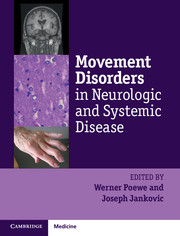Book contents
- Frontmatter
- Contents
- List of contributors
- List of videos
- List of abbreviations
- Preface
- Section I General principles
- Section II Movement disorders in systemic disease
- Chapter 4 Paraneoplastic movement disorders
- Chapter 5 Movement disorders of autoimmune origin
- Chapter 6 Movement disorders in systemic infections
- Chapter 7 Movement disorders in HIV- and AIDS-related central nervous system infections
- Chapter 8 Movement disorders in metabolic diseases in adulthood
- Chapter 9 Movement disorders in childhood metabolic diseases
- Chapter 10 Movement disorders in endocrinological diseases
- Chapter 11 Movement disorders in liver disease
- Chapter 12 Movement disorders in renal diseases
- Chapter 13 Movement disorders in hematological disease
- Section III Iatrogenic and toxic movement disorders
- Section IV Movement disorders in general neurology
- Section V Systemic complications of movement disorders
- Index
- Plate Section
- References
Chapter 13 - Movement disorders in hematological disease
from Section II - Movement disorders in systemic disease
Published online by Cambridge University Press: 05 April 2014
- Frontmatter
- Contents
- List of contributors
- List of videos
- List of abbreviations
- Preface
- Section I General principles
- Section II Movement disorders in systemic disease
- Chapter 4 Paraneoplastic movement disorders
- Chapter 5 Movement disorders of autoimmune origin
- Chapter 6 Movement disorders in systemic infections
- Chapter 7 Movement disorders in HIV- and AIDS-related central nervous system infections
- Chapter 8 Movement disorders in metabolic diseases in adulthood
- Chapter 9 Movement disorders in childhood metabolic diseases
- Chapter 10 Movement disorders in endocrinological diseases
- Chapter 11 Movement disorders in liver disease
- Chapter 12 Movement disorders in renal diseases
- Chapter 13 Movement disorders in hematological disease
- Section III Iatrogenic and toxic movement disorders
- Section IV Movement disorders in general neurology
- Section V Systemic complications of movement disorders
- Index
- Plate Section
- References
Summary
Introduction
Unlike other systemic diseases, movement disorders are infrequent in hematological disease. Although some hematological diseases, such as superficial siderosis and neuroacanthocytosis, may present initially with neurological symptoms, the majority of patients with these diseases are identified due to complications related to the underlying hematological abnormalities. Each hematological disorder will be described, with clinical manifestations, pathophysiology, and treatment, with genetic considerations if appropriate.
Hemochromatosis
Hemochromatosis is characterized by enhanced intestinal absorption of dietary iron. The presence of an association between hemochromatosis and movement disorders is controversial (Russo et al. 2004). Hereditary hemochromatosis (HH), which results in iron accumulation, is a common genetic disorder, affecting 0.5 percent of the US population. It is estimated that one in ten individuals are carriers of the most frequent mutation and they are typically Caucasians of Northern European descent (Feder et al. 1996). Movement disorders in individuals with HH have only infrequently been reported in the literature. This section will summarize the cases of movement disorders in the setting of hemochromatosis described in the literature. However, it remains unclear whether these rare cases can be attributed to hemochromatosis or are coincidental.
- Type
- Chapter
- Information
- Movement Disorders in Neurologic and Systemic Disease , pp. 189 - 202Publisher: Cambridge University PressPrint publication year: 2014



